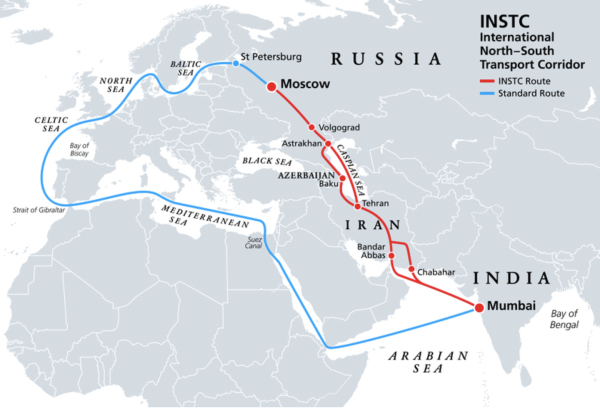Former US presidential security advisor Zbigniew Brzezinski once described two “vital geopolitical pivots” in Eurasia – Ukraine and Azerbaijan.
Brzenzinski also warned that the US should never allow the Eurasian “middle space” (Russia) to rebuff the West, become “an assertive single entity, and either gains control over the South or forms an alliance with the major Eastern actor.” (China).
Well done, neocons.
Azerbaijan is increasingly playing a key role in the integration of Eurasia, but there are a few hurdles slowing that progress, which outside actors could look to exploit to sow chaos. First, Azerbaijan’s current “vital geopolitical pivots.”
It is currently part of the most-used route of the Russia-to-India International North-South Transport Corridor (INSTC) and is a vital part of China’s land route to Europe. From Silk Road Briefing:
Transport routes passing through Azerbaijan at the moment are becoming increasingly attractive as the country creates conditions to ensure efficient transit as soon as possible. This is especially true as Baku Port has become a transport and logistics Caspian Sea gateway between Europe and China.
Azerbaijan’s onus has been to develop modern transport infrastructure in both rail, road and maritime to save money and time and compete with the Suez canal. It is working – Azerbaijan’s cargo transit volumes in 2022 increased by more than 75% over the previous year.
…Azerbaijan, being on the crossroads between East and West, has become an attractive destination. Besides the North-South Corridor, Azerbaijan has also boosted the transitional capacities of the Trans-Caspian International Transport Route, also known as the Middle Corridor. Essentially, Azerbaijan has provided incomparable conditions for the fastest, cheapest and most convenient transportation of goods.
China’s trade route to Europe via Russia has been sidetracked by the Ukraine war and western sanctions against Moscow, which makes the route across the Caspian to Azerbaijan and through the Caucuses and Turkiye much more vital.
Russia became one of India’s five largest trading partners for the first time in 2022. With so much increased trade between India and Russia since the beginning of the war in Ukraine, the two countries began to fasttrack the INSTC as a study, conducted by the Federation of Freight Forwarders’ Associations in India, showed that it will be 30 percent cheaper and 40 percent shorter than the existing routes. And according to the Russian Journal for Economics, freight traffic on the NSTC could reach 25 million tons by 2030, a 20-fold increase. For these reasons the INSTC is of vital importance to Russia, as well as a source of frustration for the neocons in DC.

But with Azerbaijan’s central positioning also comes a multitude of potential stumbling blocks.
Ever since the breakup of the USSR, Azerbaijan and Armenia have been locked in a dispute over Nagorno-Karabakh, an enclave recognized as Azerbaijani territory by the international community but mostly populated by ethnic Armenians. They fought a war there three years ago when Azerbaijan grabbed land in a six-week conflict that led to roughly 7,000 deaths. There have been periodic skirmishes ever since.
Since December Azeri “environmentalists” have been blockading the only road connecting Nagorno-Karabakh with Armenia. Baku has denied the groups have any connection to the government, but has failed to remove the blockade despite calls from nearly all sides, including both Washington and Moscow – although it’s difficult to tell how genuine those calls are. Russia has also accused Baku of violating the ceasfire in Karakbah where it maintains peacekeepers.
Azerbaijani forces also set up a new checkpoint last week near the Armenian border. This week, Democratic Congressman Adam Schiff introduced a resolution to recognise the independence and self-determination of Karabakh.
The issues between Armenia and Azerbaijan are leading to dangerous escalations between Baku and Tehran. In recent years, the Islamic Republic has become increasingly concerned that Baku is planning to seize a southern Armenian province in order to bring about a corridor that would connect all of Azerbaijan to Turkiye. Such a move would sever Iran from the Caucuses and alter the region’s power dynamics.
In response, Tehran has upped its support of Armenia and Azerbaijan has increasingly looked to Iran’s enemy Israel.
Israeli Foreign Minister Eli Cohen announced the creation of a “united front against Iran” during a press conference with his Azerbaijani counterpart Jeyhun Bayramov in Jerusalem for the opening of Azerbaijan’s embassy in Tel Aviv at the end of March. The close ties between the two are nothing new (Azerbaijan is Israel’s largest energy provider and the latter supplies the large majority of weapons to the former), but the formal declaration of a “united front” was likely in part driven by concern over the Chinese-brokered Saudi-Iranian rapprochement.
In addition to escalating military exercises on their common border, Baku and Tehran are increasingly at odds over a range of other incidents. On Jan. 27, an attack by a gunman carried out at Baku’s embassy in the Iranian capital left the head of the embassy’s security services dead and two security guards injured. Azerbaijan quickly evacuated the diplomatic post.
Azerbaijan’s Foreign Ministry in late March accused Iran of being behind the shooting attack near Baku that left a member of parliament wounded. Azerbaijani media have speculated that some of the six individuals detained in the shooting lived or traveled to Iran at various times and that the primary attacker received training from Iranian special forces. Azerbaijan’s Foreign Ministry on April 6 also expelled four Iranian Embassy employees after declaring them persona non grata. Shortly after reports emerged about Azerbaijan arresting hundreds more while the media labeled them Iranian spies. Last week Cohen was in Azerbaijan to open Israel’s first embassy in the country, located just 12 miles from the Iranian border.
A far fetched dream of Israeli and American spooks is to use Azerbaijan to inspire Azeri separatism in northern Iran and further their goal of regime change in Iran. For some idea of how this is playing out and the potential consequences, Responsible Statecraft writes:
The Iranian angle is certainly one of the key reasons behind the hawks’ enthusiasm for Azerbaijan. During the war in 2020, they cherished the dream that Azerbaijan’s military success would galvanize Iran’s sizable Azeri community against the government in Tehran. That naïve hope failed to materialize as Iranian Azeris are part and parcel of Iranian society. However, the anti-Iranian irredentist narratives gained popular currency within Azerbaijan to a degree not seen since the early 1990s. Websites with close links to the regime’s security apparatus and defense ministry issued open calls for “southern Azerbaijanis” to secede from Iran.
That was done in response to some outlandish anti-Azerbaijani remarks allegedly uttered by a retired Iranian diplomat and leaked to a Turkish newspaper. The diplomat in question, however, in no way represented the official position of the Islamic Republic. What followed — a seemingly coordinated incitement of anti-Iranian separatism in Azeri pro-regime media outlets — certainly looked like a massive over-reaction.
Pro-Azerbaijan hawks in Washington may thrive on fomenting such tensions, yet that in no way serves U.S. interests. A military conflict between Azerbaijan and Iran would suck in other countries, such as NATO ally Turkey, which would back Azerbaijan. It would most likely also involve Israel as Baku’s close ties with Jerusalem are seen as a serious threat in Tehran. Israeli officials occasionally behave as if they are keen to add fuel to the fire. The Israeli ambassador in Azerbaijan recently posed with a book of “fairy tales of Tabriz.” Given that Tabriz is the unofficial capital of Iranian Azerbaijan, many Iranians perceived this gesture as an endorsement of the Azeri separatist agenda. A regional vortex involving Iran and Israel would increase pressure from Congress on any U.S. administration to intervene on behalf of Israel.
While the odds of a direct confrontation between Azerbaijan and Iran remain low, if these tension points continue to lead to increased hostility or even some low-level of conflict, what would be the effect on the Azerbaijani pivot in the wider region?
It would be a blow to the INSTC as the western route through Azerbaijan is currently the most heavily used. According to Silk Road Briefing:
The 1,450-kilometers long Western Route is, perhaps, the most widely exploited and well-developed one. Statistics show that, from January 1 through March 28, 2023, the volume of transit of goods along the Western route totaled 2.15 million tons, a huge increase of 84.37% year-on-year (1.16 million tons transported in 2022). Only one obstacle delays the operation of the route at full capacity – 164-kilometers long Rasht-Astara railway line. However, the agreement between Iran and Russia on the construction of this line is expected to be signed by May 21, 2023. When this section is completed, the Western Route of the North-South Corridor will become fully operational. That can be expected in early-mid 2024.
But the loss of Azerbaijan as a reliable transportation route would not be a fatal blow to the INSTC as Russia made backup plans. The INSTC also has a sea route across the Caspian that connects Russia and Iran and an eastern route that does so via Kazakhstan and Turkmenistan.
It would be a major headache for another of the land connection points between China and Europe. And that would effectively make Azerbaijan’s removal from these plans (by whatever means) another barrier to Eurasian integration.


